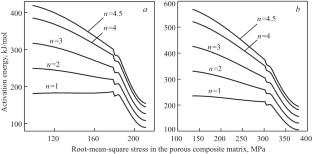The densification of a powder mixture containing titanium diboride and 20 wt.% molybdenum disilicide during nonisothermal spark plasma sintering was experimentally studied. The sintering process was assisted with an external pressure of 50.93 MPa in vacuum at a controlled constant heating rate of 1.67 and 2.72 K per second. It was established that sintering occurred when the thermodynamic temperature reached 1155 K, which should be taken as the critical brittle–ductile transition temperature for molybdenum disilicide, a less refractory material. The densification kinetics was analyzed using the continuum theory for bulk viscous flow of a porous body, considering the effect of powder particle shape on the rheological properties of the sintered body. In general, the sintering process was characterized by a decrease in the root-mean-square stress within the porous body matrix to the limiting zero value as it approached the nonporous state and by an increase in the root-mean-square strain rate along the curve with a maximum. Computational modeling of the densification kinetics for the powder composite, involving determination of the activation energy for viscous flow of the composite matrix as a function of temperature and root-mean-square stress, allowed the initial, low-temperature, and medium-temperature stages of spark plasma sintering to be identified. At the initial stage up to 1220 K, the activation energy increased nonlinearly and sharply, which can be caused by active spark flashes with the formation of plasma within the loose random packing of the powder particles, as a similar stage is not observed in conventional pressure assisted sintering. At the next low-temperature temperature stage, the activation energy increased as the root-mean square stress decreased. In the temperature range from 1300 to 1389 K, the activation energy for viscous linear flow of the composite matrix was 223 kJ/mol. In the medium-temperature range from 1414 to 1485 K, the activation energy increased to 255 kJ/mol.



